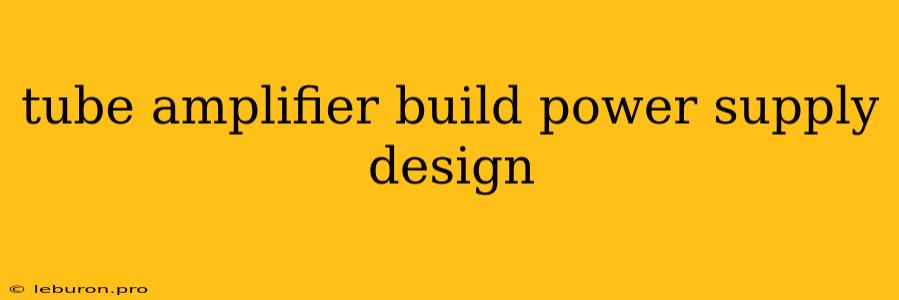Building a tube amplifier is a rewarding project for audiophiles and electronics enthusiasts alike. The power supply is a crucial component, providing the high voltages required to operate the tubes and ensuring stable and clean audio output. Designing a power supply for a tube amplifier requires careful consideration of several factors, including voltage requirements, current capacity, and filtering techniques. This article will delve into the key aspects of power supply design for tube amplifiers, guiding you through the process of building a reliable and efficient power source for your audio project.
Understanding the Basics of Tube Amplifier Power Supplies
Tube amplifiers typically operate on high voltages, ranging from hundreds to thousands of volts. These voltages are necessary to drive the tubes, which amplify the audio signal. The power supply is responsible for generating and regulating these high voltages, ensuring that they remain stable and free from unwanted noise or ripple.
Voltage Requirements
The voltage requirements for a tube amplifier are determined by the specific tubes used in the amplifier circuit. Each tube has its own operating voltage, which can vary significantly depending on its type and application. The most common voltages used in tube amplifiers are:
- Plate voltage (B+): This is the main high voltage applied to the anode of the output tubes. Typical values range from 200 to 500 volts, depending on the output tubes and the desired power output of the amplifier.
- Screen voltage (B+): This voltage is applied to the screen grid of the output tubes, typically lower than the plate voltage.
- Filament voltage (B-): This voltage is used to heat the filaments of the tubes. Typically, it is 6.3 volts for most tubes, although some may require different voltages.
Current Capacity
The current capacity of the power supply should be sufficient to meet the demands of the tube amplifier. The current draw will depend on the number of tubes used, the operating voltage, and the efficiency of the amplifier circuit. It's important to choose a transformer and rectifier components with enough current capacity to avoid overloading them.
Filtering Techniques
Filtering is crucial for removing unwanted noise and ripple from the DC output of the power supply. This noise can introduce unwanted hum or distortion into the audio signal. Common filtering techniques include:
- Capacitive filtering: This is the most common method, using capacitors to smooth out the ripple voltage.
- Inductive filtering: Using inductors in conjunction with capacitors can provide even smoother filtering.
- Choke filtering: This method uses chokes, which are inductors with high inductance, to effectively filter out ripple and noise.
Building a Tube Amplifier Power Supply
Once you have determined the voltage requirements, current capacity, and filtering techniques for your power supply, you can begin building it. Here's a step-by-step guide:
1. Selecting the Transformer
The transformer is the heart of the power supply, converting AC line voltage to the required DC voltages. When choosing a transformer, consider the following:
- Voltage output: Choose a transformer with the appropriate voltage outputs for your tube amplifier.
- Current capacity: The transformer should be rated for the total current draw of your amplifier circuit.
- Isolation: A transformer with isolation between the primary and secondary windings is crucial for safety and preventing ground loops.
2. Selecting Rectifiers
Rectifiers convert the AC output from the transformer to pulsating DC. Common types of rectifiers include:
- Diode bridges: These consist of four diodes arranged in a bridge configuration.
- Full-wave rectifiers: These use two diodes to rectify the entire AC waveform.
- Half-wave rectifiers: These use a single diode to rectify half of the AC waveform.
3. Filtering
Filtering is essential to smooth out the pulsating DC output from the rectifier and reduce ripple voltage. Choose the appropriate filtering components based on the desired ripple level and the current requirements of your amplifier.
4. Voltage Regulation
For applications requiring highly stable output voltage, voltage regulation can be implemented. This involves using a voltage regulator circuit to maintain a constant output voltage despite fluctuations in input voltage or load current.
Conclusion
Building a tube amplifier power supply involves a combination of knowledge and practical skills. By understanding the basics of tube amplifier power supply design, carefully selecting components, and applying appropriate filtering techniques, you can build a reliable and efficient power source for your tube amplifier. Remember to prioritize safety and follow all necessary precautions during the construction process. A well-designed power supply will ensure optimal performance, longevity, and a pleasurable listening experience from your tube amplifier.
